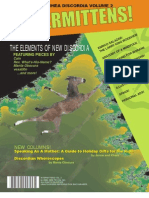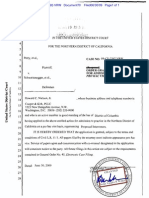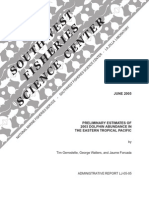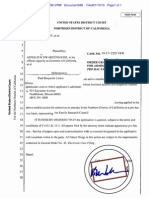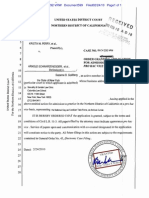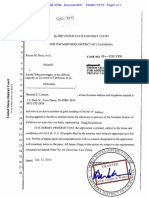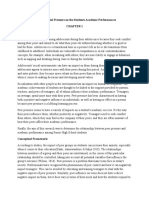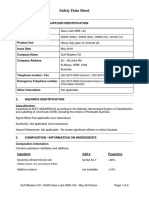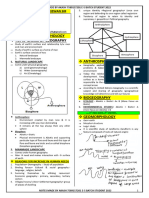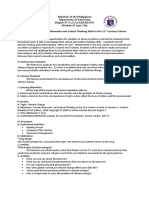4 - Climate and Global Climate Zones
4 - Climate and Global Climate Zones
Uploaded by
kaushik joshiCopyright:
Available Formats
4 - Climate and Global Climate Zones
4 - Climate and Global Climate Zones
Uploaded by
kaushik joshiOriginal Title
Copyright
Available Formats
Share this document
Did you find this document useful?
Is this content inappropriate?
Copyright:
Available Formats
4 - Climate and Global Climate Zones
4 - Climate and Global Climate Zones
Uploaded by
kaushik joshiCopyright:
Available Formats
QUICK REVISION MODULE
(UPSC PRELIMS 2022) GEOGRAPHY
CLIMATE AND GLOBAL
CLIMATE ZONES
FACTORS AFFECTING CLIMATE
Ocean Local
Latitude Altitude Continentality Current Winds
Relief & Natural Slope, Shelter Human
Topography Vegetation & Aspect El Nino Influence
FACTS ABOUT FACTORS AFFECTING CLIMATE:
om
l.c
ai
gm
A fall of 6.5°C occurs with an ascent of 1000 meters or 1.0°C per 165 meters.
5@
42
It takes less energy to raise the temperature of a given volume of land by 1.0°C as compared to same
i2
sh
volume of water body.
jo
ik
sh
Mountains receive more rainfall than low lying areas because as air is forced over the higher ground it
u
ka
cools, causing moist air to condense and fall out as rainfall.
Dry soils like sands are very sensitive to temperature changes, whereas wet soils, like clay, retain much
moisture and warm up or cool down more slowly.
Mountain ranges that have an east-west alignment like the Alps show a higher temperature on the south-
facing 'sunny slope' than the north facing 'sheltered slope’.
The warmer water pumps energy and moisture into the atmosphere, altering global wind and rainfall
patterns.
www.visionias.in Vision IAS 1
Heat Zones Classifications
THESE RAYS ALWAYS HORIZONTAL
N.
FR
NO IG
ID
RT
H T
EM
23 PE
S U N ‘ S ¹ /2 N RA S U N ‘ S
TRO OR TE
EQ PIC TH
UA
TO O F L AT
CA IT
R NC UDE
R A Y S ER R A Y S
PERPENDICULAR RAY TO PERPENDICULAR RAY
RR
ID
23
ABOUT T R O ¹/2 S O ABOUT
PIC UTH
OF L
SO
UT C A AT I T U
PR
D E C E M B E R
H T I CO D E J U N E
EM RN
PE
RA
S.
FR TE
21st I GI
D
21st
THESE RAYS ALWAYS HORIZONTAL
SOME FACTS ABOUT HEAT ZONES CLASSIFICATION:
Tropical or Torrid Zone: The sunrays are almost vertical throughout the year. The temperature always
remains high. There is no winter season in this zone.
om
l.c
Frigid Zones: The sunrays in these two zones in the Northern and Southern Hemisphere fall in slanting
ai
gm
5@
form throughout the year. Therefore these zones experience very low temperature and high degree of
42
coldness.
i2
sh
jo
ik
North Pole
sh
90°N
u
ka
66.5° Frigid zone
66.5°
23.5° Temperat e Zone 23.5°
Tro p i c s
Torrid Zone Tro p i c s
0° Equator 0°
Tro p i c s
Tro p i c s Torrid Zone
23.5° Temperat e Zone 23.5°
Frigid zone
66.5° 66.5°
90°S
South Pole
www.visionias.in Vision IAS 2
CLASSIFICATION OF CLIMATE:
Koeppen classification
Based on annual averages of temperature and precipitation. 5 main climate types + Highland type climate
S.N. Chief Climatic Groups Climatic Types
Tropical Climate (Average temperature of the coldest 1. Tropical rain forest type climate
A month is 18 C or higher) 2. Savannah type climate
3. Monsoon type climate
Dry Climate ( potential evaporation ) exceeds precipitation 4. Desert climate
B 5. Steppe (Semi-desert) climate
Temperate Climate (The average temperature of the 6. Mediterranean climate
C coldest month is higher than minus 3° C but below 18° C) 7. China type climate
8. West European type climate
Continental Climate (The average temperature of the 9. Taiga climate
D coldest month is minus 3° C or below) 10. Easter costal cold climate
11. Continental climate
E Polar Climate (Average temperature for all month is below 12. Tundra climate
10° C) 13. Snow-capped region type climate
H Highland Climate (Cold due to elevation)
Thornthwaite Classification
5 humidity region based on Precipitation effectiveness and Temperature efficiency
om
l.c
S.N. Humidity Region Special type of Vegetation
ai
gm
Very Humid
5@
A Rain Forest
42
i2
B Humid Forest
sh
jo
ik
C Semi Humid Grassland
sh
u
ka
D Semi Dry Steppe
E Dry Desert
On the basis of distribution of seasonal rainfall the above types of humidity regions were further divided
into following subdivisions:
Y = Heavy rainfall in all seasons
s = Scarcity of rainfall in summer season
w = Scarcity of rainfall in winter season
d = Scarcity of rainfall in all seasons
After linking precipitation effectiveness and seasonal distribution of rainfall to temperature anomalies,
the climates could be of 120 different types.
www.visionias.in Vision IAS 3
1. The Hot, Wet Equatorial Climate
Location
Found in the lowlands of the Amazon, the Congo, Malaysia and the East Indies
Bogota Kuala
Lumpur
hot, wet equatorial regions
om
l.c
ai
gm
5@
42
i2
sh
jo
ik
sh
Climatic Conditions
u
ka
5-10 degrees North and South of the equator.
Great uniformity of temperature throughout the year (around 27°C).
No winter. Cloudiness and heavy precipitation moderates the daily temperature.
Vegetation
Multitude of evergreen trees that yield tropical hardwood.
Lianas, epiphytic and parasitic plants are also found.
www.visionias.in Vision IAS 4
2. The Tropical Monsoon and Tropical Marine Climates
Location
Tropical Monsoon Climate:
They are best developed in the Indian sub-continent, Burma, Thailand, Laos, Cambodia, parts of Vietnam
and south China and northern Australia.
Tropical Marine Climate:
It is experienced in Central America. West Indies, north-eastern Australia, the Philippines, parts of East
Africa, Madagascar, the Guinea Coast and eastern Brazil.
Cairns
Tropical marine
Tropical monsoon
om
l.c
ai
gm
5@
42
i2
Climatic Conditions
sh
jo
ik
sh
Found in the zones between 5° and 30° latitudes on either side of the equator.
u
ka
The basic cause of monsoon climates is the difference in the rate of heating and cooling of land and sea.
Tropical Monsoon Climate: In regions like the Indian sub-continent which have a true Tropical Monsoon
Climate, three distinct seasons are distinguishable - The cool, dry season (October to February), the hot
dry season (March to mid-June) and the rainy season (mid-June to September).
Tropical Marine Climate: This type of climate is experienced along the eastern coasts of tropical lands,
receiving steady rainfall from the Trade Winds all the time.
Vegetation
Trees are normally deciduous because of the marked dry period, during which they shed their leaves to
withstand the drought.
Where the rainfall is heavy, e.g. in Southern Burma, peninsular India, northern Australia and coastal
regions with a tropical marine climate, the resultant vegetation is forest.
www.visionias.in Vision IAS 5
3. The Savannah or Sudan Climate
Location
The Savannah or Sudan Climate is a transitional type of climate found between the equatorial forest and
the trade wind hot deserts
It is confined within the tropics and is best developed in the Sudan where the dry and wet seasons are
most distinct, hence its name the Sudan Climate.
The belt includes West African Sudan, and then curves southwards into East Africa and southern Africa
north of the Tropic of Capricorn.
In South America, there are two distinct regions of savannah north and south of the equator, namely the
llanos of the Orinoco basin and the Campos of the Brazilian Highlands.
Tropic of Cancer
Kang
Lianos
Equator
Salisbury
Tropic of Capricorn Campos
om
l.c
ai
gm
Savanna
5@
42
i2
sh
jo
ik
sh
u
ka
Climatic Conditions
It is characterized by distinct wet and dry seasons.
The extreme diurnal range of temperature is also a characteristic of Sudan type of climate.
The prevailing winds of the region are the Trade Winds which bring rain to the coastal districts.
The savannah, particularly in Africa, is the home of wild animals. It is known as the 'big game country’.
Vegetation
Tall grass and short trees. The terms 'parkland' or 'bush-veld’ is also used.
The trees are deciduous and show adaptation to withstand drought.
www.visionias.in Vision IAS 6
4. The Hot Desert and Mid-latitude Desert Climates
Location
They include the Sahara Desert, the Great Australian Desert , the Arabian Desert, Iranian Desert, Thar
Desert, Kalahari and Namib Deserts.
In North America, the desert extends from Mexico to USA and is called by different names at different
places, e.g. the Mohave Sonoran, Californian and Mexican Deserts.
In South America, the Atacama or Peruvian Desert (driest). The Patagonian Desert is more due to its rain-
shadow position on the leeward side of the lofty Andes than to continentality
Turkestan
Gobi
Mohave
ian
Canaries Kasngar
n
Cal urre
Ira
Current Thar
Sahara
C
ifo nt
Ara
rni
bia
Massawa n
an
Atacama Kalahari
Benguela
Current Namib Australian
Peruv nt
W. Australian
Curre
Current
Patagonian
ain
om
Hot Desert
l.c
ai
gm
Mid Latitude deserts
5@
cold ocean currents
42
i2
sh
jo
ik
sh
u
ka
Climatic Conditions
The major hot deserts of the world are located on the western coasts of continents between latitudes 15
and 30 degrees N and S.
The hot deserts lie astride the Horse Latitudes or the Sub Tropical High Pressure Belts where the air is
descending (least favourable for precipitation)
There is no cold season in the hot deserts and the average summer temperature is around 30°C.
Vegetation
Vegetation include grass, scrub, herbs, weeds, roots or bulbs.
www.visionias.in Vision IAS 7
5. The Warm Temperate Western Margin (Mediterranean) Climate
Location
The basic cause of this type of climate is the shifting of the wind belts.
Though the area around the Mediterranean Sea has the greatest extent of this type of 'winter rain
climate', and gives rise to the more popular name Mediterranean Climate.
Other Mediterranean regions include California (around San Francisco), the south-western tip of Africa
(around Cape Town), southern Australia (in southern Victoria and around Adelaide, bordering the St.
Vincent and Spencer Gulfs), and south-west Australia (Swanland).
Mistral
Sirocco
Cape Town
Mediterranean regions
om
l.c
ai
gm
Climatic Conditions
5@
42
i2
They are entirely confined to the western portion of continental masses, between 30° and 45° north and
sh
jo
south of the equator.
ik
sh
The Mediterranean type of climate is characterized by very distinctive climatic features - a warm summer
u
ka
with off-shore trades, a concentration of rainfall in winter with onshore westerlies, bright, sunny
weather with hot dry summers and wet, mild winters and the prominence of local winds around the
Mediterranean Sea (Sirocco, Mistral).
Growth is slow in the cooler and wetter season, even though more rain comes in winter. The warm, bright
summers and cool, moist winters enable a wide range of crops to be cultivated Some 85 per cent of
grapes produced, go into wine. The long, sunny summer allows the grapes to ripen and then they are
handpicked. Economy: The area is important for fruit cultivation, cereal growing, wine-making and
agricultural industries as well as engineering and mining.
Vegetation
The Mediterranean lands are also known as the world's orchard lands. A wide range of citrus fruits such as
oranges, lemons, limes, citrons and grapefruit are grown. Wine production is another specialty.
The absence of shade is a distinct feature of Mediterranean lands.
www.visionias.in Vision IAS 8
6. The Temperate Continental (Steppe) Climate
Location
In Eurasia: Steppes. Stretch eastwards from the Black Sea to the Altai Mountains.
In North America: Prairies. They lie between the Rockies and the Great Lakes.
In South America: Pampas of Argentina and Uruguay. Extend right to the sea and enjoy much maritime
influence.
In South Africa: Tropical Bushveld in North and High Veld in the South. They lie between the Drakensberg
and the Kalahari Desert.
Manchuria
Winnipeg Grassland
Pustaz
Prairies
Steppes
k
noo
Chi nds
wi
Pretoria Downs
Veld
Pampas
Temperate Grasslands Canterbury
Grassland
om
Warm ocean currents
l.c
ai
gm
5@
42
i2
sh
Climatic Conditions
jo
ik
sh
u
Summers are very warm and winters are very cold in the continental steppes of Eurasia because of the
ka
enormous distances from the nearest sea.
In contrast, the steppe type of climate in the southern hemisphere is never severe. The winters are mild.
Temperatures below freezing point are exceptional.
Temperate grasslands are found bordering the deserts, away from the Mediterranean regions and in the
interiors continents.
Their greatest difference from the tropical savannah is that they are practically treeless and the grasses
are much shorter.
Vegetation
Trees are very scarce in the steppes, because of the scanty rainfall, long droughts and severe winters.
Tall, fresh and nutritious prairie grass are found. Granaries of the world.
www.visionias.in Vision IAS 9
7. The Warm Temperate Eastern Margin (China Type) Climate
Location
It can be sub-divided into three main types:
The China type: Central and North China including southern Japan (temperate monsoonal).
The Gulf type: South-eastern United States bordering Gulf of Mexico (slight monsoonal).
The Natal type: The entire warm temperate eastern margin (non-monsoonal areas) of the southern
hemisphere including Natal, eastern Australia and southern Brazil-Paraguay-Uruguay and northern
Argentina.
do
Torna
Hurricane
Track Nanking
Ty
Miami ph
oo
n Tra
ck
Pampero Berg Wind Sydney
rly
t he r
u e
So urst
om
Warm temperate eastern margin regions
l.c
B
ai
Local winds
gm
5@
42
i2
sh
jo
ik
sh
u
ka
Climatic Conditions
Warm moist summer and a cool, dry winter.
Fairly uniform distribution of rainfall throughout the year.
It has comparatively more rainfall than the Mediterranean climate.
The eastern margins of warm temperate latitudes have a much heavier rainfall than either the western
margins or the continental interiors and thus have luxuriant vegetation.
Vegetation
Lowlands: Evergreen broad-leaved forests and deciduous trees.
Highlands: Conifers such as pines and cypresses that are important softwood.
www.visionias.in Vision IAS 10
8. The Cool Temperate Western Margin (British Type) Climate
Location
Permanent influence of Westerlies through out the year.
They are also regions of much cyclonic activity, typical of Britain.
Climatic belt stretches from Britain to North-West Europe.
In the southern hemisphere, the climate is experienced in southern Chile, Tasmania and most parts of
New Zealand, particularly in South Island.
London
om
rt
l.c
ba
ai
gm
Ho
British Type of climate
5@
42
i2
sh
jo
ik
sh
u
ka
Climatic Conditions
Summers are never very warm.
Adequate rainfall throughout the year with a tendency towards a slight winter or autumn maximum
from cyclonic sources.
The rain-bearing winds come from the west, the western margins have the heaviest rainfall.
Vegetation
Deciduous forests used for Lumbering
Trees shed their leaves in winter as a protection mechanism.
www.visionias.in Vision IAS 11
9. The Cool Temperate Continental (Siberian) Climate
Location
Experienced only in the northern hemisphere where the continents within the high latitudes have a
broad east-west spread.
The Siberian Climate is conspicuously absent in the southern hemisphere because of the narrowness of
the southern continents in the high latitudes.
Churchill
Moscow
om
coniferous forest
l.c
ai
gm
5@
42
i2
sh
jo
ik
sh
Climatic Conditions
u
ka
Characterized by a bitterly cold winter of long duration, and a cool brief summer. Spring and autumn are
merely brief transitional periods.
The extremes of temperature are so great in Siberia that it is often referred to as the 'cold pole of the
earth’.
Some of the lowest temperatures in the world are recorded in Verkhoyansk.
Vegetation
Coniferous forests (Softwood)
There are four major species in the coniferous forests – a) Pine, e.g. white pine, red pine b) Fir, e.g.,
Douglas fir and balsam fir, c) Spruce and d) Larch.
www.visionias.in Vision IAS 12
10. The Cool, Temperate Eastern Margin Climate
Location
This climate is found only in two regions.
North American Region: north-eastern North America, including eastern Canada, north-east U.S.A. and
Newfoundland.
Asiatic Region: The eastern coastlands of Asia, including eastern Siberia, North China, Manchuria, Korea
and northern Japan.
In the southern hemisphere, this climatic type is absent because only a small section of the southern
continents extends south of the latitude of 40° S.
om
l.c
ai
gm
5@
42
i2
sh
jo
ik
sh
u
ka
Climatic Conditions
This climate has cold, dry winters and warm, wet summers
It has features of both the maritime and the continental climates.
It is an intermediate type of climate between the British and the Siberian type of climate.
Vegetation
The predominant vegetation of the Laurentian type of climate is cool temperate forest.
Oak, beech, maple and birch are the principal trees.
www.visionias.in Vision IAS 13
11. The Polar Climate
Location
Two subtypes:
Tundra Climate
Ice-Cap Climate
om
l.c
ai
gm
5@
42
i2
sh
jo
ik
sh
u
ka
Climatic Conditions
Exists poleward beyond 70° latitude.
Tundra-Climate [ET] is found in regions with permafrost. Short growing season i.e. summer with very
long duration of day light. Drainage in the tundra is usually poor as the sub-soil is permanently frozen.
The ice cap climate (EF) occurs over interior Greenland and Antarctica. Even in summer, the temperature
is below freezing point.
Vegetation
Tundra vegetation i.e. Mosses, Lichens and flowering plants.
www.visionias.in Vision IAS 14
The Global climatic conditions can be studied under the following twelve classifications.
Latitude Rainfall Regime Natural
Climatic Zone Climatic Type
(Approachmate ) (with approx. total) Vegetation
1. Hot wet Rainfall all year Equatorial rain
Equatorial Zone 0°-10°N and S equatorial round: 80 inches forests
Heavy summer
2. a) Tropical
rain: 80 inches Monsoon
Hot Zone 10°-30°N and S Monsoon
b) Tropical Marine Much summer forests
rain: 70 inches
3. Sudan Type Rain mainly in Savanna (tropical
summer: 30 inches grassland)
4. Desert: a)
Saharan type Desert vegetation
Little rain: 5 inches
b) Mid-latitide type and scrub
5. Western Margin Mediterranean
Warm Temperate Winter rain: 35
10°-40°N and S (Mediterranean forests and
Zone type) inches shrub
6. Central Steppe or
Light summer rain: temperate
Continental
(Steppe type ) 20 inches grassland
om
7. Eastern Margin:
l.c
a) China type Light summer rain: Warm, wet forests
ai
gm
b) Gulf type 20 inches and bamboo
5@
c) Natal type
42
i2
sh
jo
Cool Temperate 8. Western Margin More rain in autuma
ik
45°-65°N and S Deciduous forests
sh
Zone (British type) & winter: 30 inches
u
ka
9. Cental Continental Light summer rain: Evergreen
(Siberian type) 25 inches coniferous
forests
10. Eastern Margin Moderate summer Mixed forests
(Laurentian type ) rain: 40 inches (coniferous and
deciduous)
Cool Zone Very light summer Tundra, mosses,
65°-90°N and S 11. Arctic or Polar
rain: 10 inches lichens
Alpine Zone 65°-90°N and S 12. Mountain Heavy rainfall Alpine pastures,
climate (variable) conifers, fern, show
www.visionias.in Vision IAS 15
You might also like
- Metodo Claude Gordon CompletoDocument153 pagesMetodo Claude Gordon Completocamilo100% (4)
- Intermittens v2 LosslessDocument32 pagesIntermittens v2 Losslessjablair51100% (6)
- Community Tax Certificate: IndividualDocument1 pageCommunity Tax Certificate: Individualrico mangawiliNo ratings yet
- AC72063 AFM PT 5 Tactics For Stability PDFDocument198 pagesAC72063 AFM PT 5 Tactics For Stability PDFKebede Michael100% (2)
- Student Full Name Preferred Name Unit Code BSBWOR203 Unit Name Work Effectively With Others Trainer/Assessor Due DateDocument9 pagesStudent Full Name Preferred Name Unit Code BSBWOR203 Unit Name Work Effectively With Others Trainer/Assessor Due Datejiajie lu100% (1)
- DR Vego - The Falklands-Malvinas Conflict of 1982Document99 pagesDR Vego - The Falklands-Malvinas Conflict of 1982Noe Cuervo100% (1)
- Tech Transfer E Book r8Document11 pagesTech Transfer E Book r8Kush MukherjiNo ratings yet
- 40 C 8 A 47 ADocument201 pages40 C 8 A 47 Aogah mosesNo ratings yet
- AShortTableofIntegrals 10730228Document163 pagesAShortTableofIntegrals 10730228nhan2006hhbNo ratings yet
- Bengal in 1756-57 A Selection of Public and Private Papers Dealing With v3 1000508804Document512 pagesBengal in 1756-57 A Selection of Public and Private Papers Dealing With v3 1000508804amlan deNo ratings yet
- Effective: October 24, 2016: Commuter Rail ScheduleDocument6 pagesEffective: October 24, 2016: Commuter Rail ScheduleCole JoinerNo ratings yet
- Follow-Up Care 133 Fever 100 HT 70 Supervision of Norm 54 Gastritis 47 Common Cold 38 28 26 26 24Document3 pagesFollow-Up Care 133 Fever 100 HT 70 Supervision of Norm 54 Gastritis 47 Common Cold 38 28 26 26 24puskesmasselemadegNo ratings yet
- SurveyingandLevellingInstrumentsTheoreticallyandPracticallyDescribed 10258646 PDFDocument631 pagesSurveyingandLevellingInstrumentsTheoreticallyandPracticallyDescribed 10258646 PDFLalrammawiaNo ratings yet
- June 30, 2009: Es DiDocument1 pageJune 30, 2009: Es DiEquality Case FilesNo ratings yet
- Battle of The Bands 2022 Event PosterDocument1 pageBattle of The Bands 2022 Event PosterdistrictalskauswaganNo ratings yet
- 1.2 Problem Solving ApproachDocument8 pages1.2 Problem Solving ApproachAshwin JudalNo ratings yet
- Chatterbox Ver 1Document2 pagesChatterbox Ver 1VenujaNo ratings yet
- AdonisAttisOsiris 10015092Document338 pagesAdonisAttisOsiris 10015092SandaBrezniceanuNo ratings yet
- June 30, 2009: Es DiDocument1 pageJune 30, 2009: Es DiEquality Case FilesNo ratings yet
- AShortHistoryofSwitzerland 10080157Document340 pagesAShortHistoryofSwitzerland 10080157grinpisuNo ratings yet
- John Taylor - The Art of Defence On Foot, With The Broad Sword and SabreDocument149 pagesJohn Taylor - The Art of Defence On Foot, With The Broad Sword and SabreMadalinaNo ratings yet
- Gerrodette Et AlDocument28 pagesGerrodette Et Alapi-3828346No ratings yet
- IPCC WGI Science 08 Aug 2022Document1 pageIPCC WGI Science 08 Aug 2022SamiNo ratings yet
- United States District Court Northern District of CaliforniaDocument1 pageUnited States District Court Northern District of CaliforniaEquality Case FilesNo ratings yet
- SignsandSymbolsIllustratedandExplainedinaCourseofTwelveLecturesonFreemasonry 10821681Document291 pagesSignsandSymbolsIllustratedandExplainedinaCourseofTwelveLecturesonFreemasonry 10821681andre.z.demolayNo ratings yet
- 06 Schematic DiagramDocument1 page06 Schematic DiagramFazrullaKhanNo ratings yet
- Opening and Closing Program Inset JournDocument4 pagesOpening and Closing Program Inset JournJoel Velasco LozanoNo ratings yet
- Woo1993 PDFDocument27 pagesWoo1993 PDFUndrah TsogooNo ratings yet
- Es Di: Grant EDDocument1 pageEs Di: Grant EDEquality Case FilesNo ratings yet
- United States District Court Northern District O F CaliforniaDocument1 pageUnited States District Court Northern District O F CaliforniaEquality Case FilesNo ratings yet
- Comparison Between Small and Large LNG Plant 2023Document16 pagesComparison Between Small and Large LNG Plant 2023TONY KAROUTNo ratings yet
- Eng PDFDocument56 pagesEng PDFLaura Palma MisatNo ratings yet
- Project Admi Dimmer TopDocument1 pageProject Admi Dimmer TopHeralfy AliandiNo ratings yet
- Activity 7.1 Volcanoes and EarthquakesDocument7 pagesActivity 7.1 Volcanoes and EarthquakesJanine Alexis TividadNo ratings yet
- Endodontic Glossary Apical Delta Renovo Endodontic StudioDocument1 pageEndodontic Glossary Apical Delta Renovo Endodontic Studioaws.rajeh2018No ratings yet
- YellowSubmarine TheLastAstronautDocument11 pagesYellowSubmarine TheLastAstronautAlejandro JaureguiNo ratings yet
- Es Di: Grant EDDocument1 pageEs Di: Grant EDEquality Case FilesNo ratings yet
- TransactionsoftheBibliographicalSociety 10280320Document242 pagesTransactionsoftheBibliographicalSociety 10280320Laksmankanth IndrakaranNo ratings yet
- TheMassandVestmentsoftheCatholicChurch 10100197 PDFDocument540 pagesTheMassandVestmentsoftheCatholicChurch 10100197 PDFVictor Hugo Oliveira VelosoNo ratings yet
- Invoice JR Mandiri SuksesDocument1 pageInvoice JR Mandiri Sukseskantor pilar perkasa indonesiaNo ratings yet
- June 30, 2009: Es DiDocument1 pageJune 30, 2009: Es DiEquality Case FilesNo ratings yet
- Hallow inDocument1 pageHallow inAndrésFelipePoloNo ratings yet
- Cost StructureDocument36 pagesCost StructureNiken Lestari GNo ratings yet
- Underground Is The Future Mine - DEMR PDFDocument37 pagesUnderground Is The Future Mine - DEMR PDFasepdayatNo ratings yet
- Calmac Ice Storage AircoDocument4 pagesCalmac Ice Storage AircosukamtoNo ratings yet
- Es Di: Grant EDDocument1 pageEs Di: Grant EDEquality Case FilesNo ratings yet
- ACatalogueoftheTeluguBooksintheLibraryoftheBritishMuseum 10665926Document232 pagesACatalogueoftheTeluguBooksintheLibraryoftheBritishMuseum 10665926bharathostNo ratings yet
- 2011-2030 CLUP Annex 5.3 Transitional AreasDocument3 pages2011-2030 CLUP Annex 5.3 Transitional AreasCath AnilaNo ratings yet
- A N T Igue R A D IOC L ASS IF IED: 2 November 1 995 Number 1 1Document106 pagesA N T Igue R A D IOC L ASS IF IED: 2 November 1 995 Number 1 1Pablo OddoneNo ratings yet
- 5 AcknowledgementDocument9 pages5 AcknowledgementMuhammad Mostafizur RahmanNo ratings yet
- Slac School FormsDocument37 pagesSlac School FormsMarcela Caig-GarciaNo ratings yet
- P.A. BossesDocument33 pagesP.A. Bossesyuani fitriNo ratings yet
- Case NO. 09-cv-2292-VRW: Hac ViceDocument1 pageCase NO. 09-cv-2292-VRW: Hac ViceEquality Case FilesNo ratings yet
- ShifterDocument1 pageShifternflronkNo ratings yet
- SF 1Document5 pagesSF 1Jenny Mae MajesterioNo ratings yet
- Tayanga Pessel - EnglishDocument15 pagesTayanga Pessel - EnglishHadi SusiloNo ratings yet
- Fresh Layout of Vrapps and Asha School 10 Dec 22Document13 pagesFresh Layout of Vrapps and Asha School 10 Dec 22duruvas1991No ratings yet
- 9 - Language and LiteratureDocument11 pages9 - Language and Literaturekaushik joshiNo ratings yet
- 5 Dance of IndiaDocument10 pages5 Dance of Indiakaushik joshiNo ratings yet
- 4 - Important Kingdom of North and South IndiaDocument16 pages4 - Important Kingdom of North and South Indiakaushik joshiNo ratings yet
- 3 - Gupta and Harsha PeriodDocument12 pages3 - Gupta and Harsha Periodkaushik joshiNo ratings yet
- 2 MahajanpadasDocument24 pages2 Mahajanpadaskaushik joshiNo ratings yet
- 4.EF1B2 HDT NPA BadLoans BASEL PCB7 1658489879491Document41 pages4.EF1B2 HDT NPA BadLoans BASEL PCB7 1658489879491kaushik joshiNo ratings yet
- 1 Ancient-IndiaDocument14 pages1 Ancient-Indiakaushik joshiNo ratings yet
- Life Skills (Flips) - : Christian Maluyo DHRT - 1ADocument5 pagesLife Skills (Flips) - : Christian Maluyo DHRT - 1AJonel BarrugaNo ratings yet
- RAM Handout A3Document2 pagesRAM Handout A3Teck Tiong HuanNo ratings yet
- Effects of Social Pressure On The Students Academic PerformancesDocument7 pagesEffects of Social Pressure On The Students Academic Performancesprincess3canlasNo ratings yet
- Developments in Thermal Desalination Processes PDFDocument14 pagesDevelopments in Thermal Desalination Processes PDFG.DNo ratings yet
- Polyflex T: Flexible, Waterproofing and Protective Slurry MortarDocument2 pagesPolyflex T: Flexible, Waterproofing and Protective Slurry MortarVaittianathan MahavapillaiNo ratings yet
- 1-Intro. Civic & Community EngagementDocument12 pages1-Intro. Civic & Community Engagementahmedaaliyan250No ratings yet
- Biodiversity and A Healthy SocietyDocument5 pagesBiodiversity and A Healthy Society5555-899341No ratings yet
- Gear Lube 85W 140 May 2018Document6 pagesGear Lube 85W 140 May 2018LismiantoNo ratings yet
- Paint MasterDocument6 pagesPaint MasterRozaiman OsmanNo ratings yet
- Piura River MasterplanDocument409 pagesPiura River MasterplanCesar MondragonNo ratings yet
- P O R T F O L I O: Sonali Chamadia - A03 Building MaterialsDocument7 pagesP O R T F O L I O: Sonali Chamadia - A03 Building MaterialsSonali ChamadiyaNo ratings yet
- (The Handbook of Environmental Chemistry 73) Abdelazim M. Negm - Groundwater in The Nile Delta (2019, Springer International Publishing)Document753 pages(The Handbook of Environmental Chemistry 73) Abdelazim M. Negm - Groundwater in The Nile Delta (2019, Springer International Publishing)Kebede MichaelNo ratings yet
- Food Traceability PPT 01Document25 pagesFood Traceability PPT 01Muddasir Ahmad Akhoon100% (4)
- The Global Tree Restoration PotentialDocument5 pagesThe Global Tree Restoration PotentialPiyush SharmaNo ratings yet
- (MR) Geography MD - Rizwan SirrDocument50 pages(MR) Geography MD - Rizwan Sirrsarika07072019No ratings yet
- Coca-Cola Beverages Philippines, Inc (CSR)Document17 pagesCoca-Cola Beverages Philippines, Inc (CSR)Stephanie Cristy Lacangulo100% (1)
- Nash 1970Document10 pagesNash 1970joaopaulogmNo ratings yet
- (Advances in Marine Biology 44) A. Southward, Et Al.,-Elsevier (2003)Document330 pages(Advances in Marine Biology 44) A. Southward, Et Al.,-Elsevier (2003)bruhmeister03No ratings yet
- Woodhead Publishing Series I 2015 Advances in Battery Technologies For ElectDocument5 pagesWoodhead Publishing Series I 2015 Advances in Battery Technologies For ElectMayur DeokarNo ratings yet
- 7-8 State Cartography 2022Document36 pages7-8 State Cartography 2022Yanqing YangNo ratings yet
- State Pollution Control Board, Odisha: No. I), Cte - Office MemorandumDocument3 pagesState Pollution Control Board, Odisha: No. I), Cte - Office Memorandumkrish659No ratings yet
- Fish and Fisheries - 2020 - Song - Collateral Damage Small Scale Fisheries in The Global Fight Against IUU FishingDocument13 pagesFish and Fisheries - 2020 - Song - Collateral Damage Small Scale Fisheries in The Global Fight Against IUU FishingBùi Mạnh MạnhNo ratings yet
- Family Consum Sci Res J - 2023 - Manley - Exploring The Perceptions and Motivations of Gen Z and Millennials TowardDocument15 pagesFamily Consum Sci Res J - 2023 - Manley - Exploring The Perceptions and Motivations of Gen Z and Millennials TowardgouthamsNo ratings yet
- Earth and Life Science - Week2Document7 pagesEarth and Life Science - Week2Krisna Cortes Fernandez100% (1)
- Us 2021 EnglishDocument17 pagesUs 2021 EnglishNurbaeti SyachrirNo ratings yet
- NSS Report 7th Sem (3)Document13 pagesNSS Report 7th Sem (3)ayman patilNo ratings yet
- Final SWM Micro ProjectDocument19 pagesFinal SWM Micro ProjectPratiksha BharatiNo ratings yet
- COpyDocument220 pagesCOpyNishanth GaddamNo ratings yet
- Lesson Plan in Trends, Networks and Critical Thinking Skills in The 21st CenturyDocument2 pagesLesson Plan in Trends, Networks and Critical Thinking Skills in The 21st CenturyRio Jaena Dimayuga100% (5)

